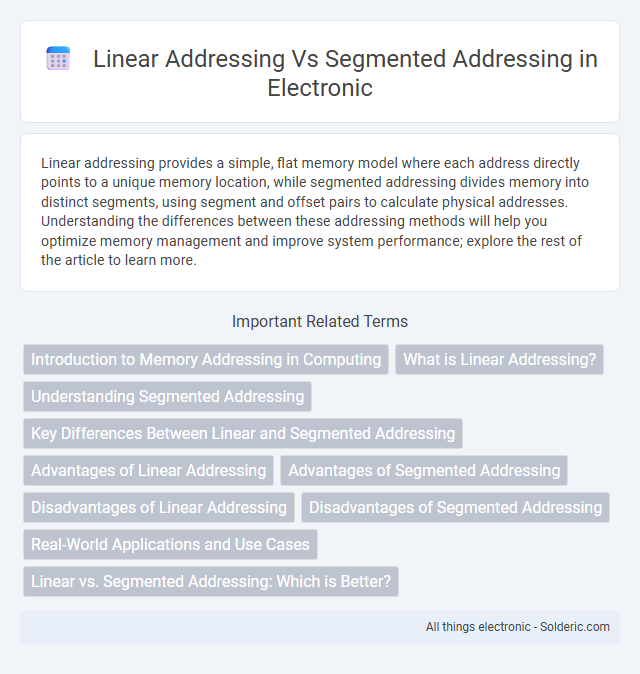Linear addressing provides a simple, flat memory model where each address directly points to a unique memory location, while segmented addressing divides memory into distinct segments, using segment and offset pairs to calculate physical addresses. Understanding the differences between these addressing methods will help you optimize memory management and improve system performance; explore the rest of the article to learn more.
Comparison Table
| Aspect | Linear Addressing | Segmented Addressing |
|---|---|---|
| Definition | Memory accessed using a single continuous address space. | Memory accessed by segment selector and offset within segments. |
| Address Format | Single linear address (e.g., 32-bit flat address). | Segment:Offset pair (e.g., 16-bit segment, 16-bit offset). |
| Complexity | Simpler, direct addressing. | More complex, requires segment registers and descriptor tables. |
| Memory Management | No memory segmentation; contiguous memory model. | Enables isolation and protection via segment limits and attributes. |
| Usage | Used in modern flat memory models (e.g., 32-bit/64-bit systems). | Used in older architectures like x86 real mode and protected mode segmentation. |
| Address Translation | Direct mapping from address to physical memory. | Segment base address + offset combined for physical address. |
| Protection | Limited or relies on separate mechanisms (paging, rings). | Built-in protection via segment descriptors. |
| Performance | Generally faster due to simpler address computation. | Potentially slower due to segment lookups and checks. |
Introduction to Memory Addressing in Computing
Memory addressing in computing involves different methods to locate data within a system's memory, primarily linear addressing and segmented addressing. Linear addressing uses a single, continuous address space, simplifying memory management and enabling direct access to any memory location. Segmented addressing divides memory into segments, combining a segment selector and an offset to calculate the effective address, which can enhance modularity but may require more complex address translation.
What is Linear Addressing?
Linear addressing refers to a memory addressing scheme where each memory location is identified by a unique, continuous address in a single address space, simplifying access to physical memory. This method contrasts with segmented addressing, which divides memory into distinct segments with their own base addresses, requiring calculations to determine the actual physical address. Your system benefits from linear addressing by enabling straightforward and efficient memory management, especially in modern 32-bit and 64-bit processors.
Understanding Segmented Addressing
Segmented addressing divides memory into fixed-size segments, each with its own segment selector and offset, allowing more efficient memory management in limited address spaces. This method contrasts with linear addressing, which uses a single continuous address space, offering simplicity but less flexibility for complex memory protection and organization. Understanding segmented addressing helps you optimize program memory layout and leverage hardware features for enhanced security and multitasking.
Key Differences Between Linear and Segmented Addressing
Linear addressing uses a single, continuous address space, simplifying memory management by referencing memory locations with straightforward, flat addresses. Segmented addressing divides memory into different segments, each with a base address and offset, allowing more flexible memory organization but requiring additional computation to translate addresses. Your choice between these methods impacts system design, efficiency, and ease of programming in terms of memory access and protection.
Advantages of Linear Addressing
Linear addressing simplifies memory management by providing a single, continuous address space, which allows faster and more efficient access to data compared to segmented addressing. This approach eliminates the complexity of segment registers and offset calculations, reducing overhead and potential for segmentation faults. You can achieve improved performance and easier programming in systems that utilize linear addressing for memory access.
Advantages of Segmented Addressing
Segmented addressing offers enhanced memory organization by dividing memory into segments, which simplifies managing large programs and data structures. It enables easier protection and sharing of memory segments, improving overall system stability and security. Your applications benefit from efficient memory utilization and more flexible access control through this addressing method.
Disadvantages of Linear Addressing
Linear addressing simplifies memory management but suffers from significant limitations such as a fixed address space that restricts scalability and flexibility in complex systems. It can lead to inefficient utilization of memory, increasing the risk of fragmentation and limiting protection by allowing any process to access the entire address range. Your system may face difficulties handling multitasking and memory protection compared to segmented addressing, which divides memory into manageable, isolated segments.
Disadvantages of Segmented Addressing
Segmented addressing complicates memory management by requiring the processor to calculate physical addresses using both segment and offset values, leading to slower access times compared to linear addressing. It limits the available address space since each segment has a fixed maximum size, typically 64KB, which constrains program and data size flexibility. Your system may experience fragmentation and overhead in segment handling, making debugging and memory allocation more cumbersome than with linear addressing models.
Real-World Applications and Use Cases
Linear addressing is widely used in modern operating systems and applications requiring large, continuous memory spaces, such as multimedia processing and virtual memory management, due to its simplicity and efficiency. Segmented addressing remains relevant in legacy systems and real-time embedded environments where memory isolation and protection are critical, exemplified by early x86 architecture and microcontroller designs. Understanding both addressing modes aids software developers in optimizing performance and compatibility across diverse hardware platforms.
Linear vs. Segmented Addressing: Which is Better?
Linear addressing provides a straightforward, continuous memory model that simplifies programming and enhances performance by eliminating the need for segment calculations, making it ideal for modern 32-bit and 64-bit architectures. Segmented addressing divides memory into discrete segments, allowing modularization and protection in legacy systems like x86 real mode but introduces complexity and overhead in address translation. For contemporary applications, linear addressing is generally superior due to its efficiency, scalability, and ease of use in large address spaces.
linear addressing vs segmented addressing Infographic

 solderic.com
solderic.com